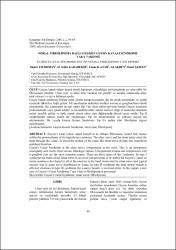Nöral fibrolipoma bağlı gelişen guyon kanalı sendromu: Vaka takdimi
Nöral fibrolipoma bağlı gelişen guyon kanalı sendromu: Vaka takdimi
Abstract
Guyon kanalı (ulnar karpal tünel) hipotenar yüksekliğin proksimalinde yer alan oblik bir fibroosseöz tüneldir. Ulnar sinir ve ulnar arter buradan ele girerler ve kanalın ortalarında ulnar sinir yüzeyel ve derin dallarına ayrılır.
Guyon kanalı sendromu bilekte ulnar sinirin kompresyonudur. Bu bir tuzak nöropatidir ve çeşitli etyolojik faktörlere bağlı gelişir. Sık karşılaşılan nedenleri mesleki travma ve ganglion kisti olarak sıralanabilir. Bu sendromun üç tipi vardır.Tip I’de ulnar sinirin gövdesi hemen Guyon kanalının proksimalinde veya içinde tutulur ve bu nedenle ulnar sinirin innerve ettiği el kaslarının tümünde motor zayıflık gelişir ve tipik olarak olarak ulnar sinir dağılımında duysal kayıp vardır. Tip II sendromunda sadece motor dal tutulmuştur. Tip III sendromunda ise yalnızca duysal dal etkilenmiştir. Bu yazıda Guyon Kanalı Sendromu Tip I’e neden olan fibrolipom olgusu sunulmuştur. Guyon’s canal (ulnar carpal tunnel) is an oblique fibroosseus tunnel that locates within the proximal part of the hypothenar eminence. The ulnar nerve and the ulnar artery enter the hand through this canal. At about the middle of the canal, the ulnar nerve divides into superficial and deep branches.
Guyon's Canal Syndrome is the ulnar nerve compression at the wrist. This is an entrapment neuropathy and results from various ethiologic factors. Occupational trauma and compression with a ganglion cyst are the most common causes. There are three types of this syndrome. In type I syndrome the trunk of the ulnar nerve is involved just proximal of or within the Guyon's Canal, so motor weakness developed in all of the muscles in the hand innervated by ulnar nerve and typical sensory loss in ulnar nerve distribution is found. In type II syndrome the deep motor branch is affected whereaes in type III syndrome the sensory branch is involved alone. In this report, a rare case of Guyon’s Canal Syndrome Type I due to fibrolipoma is presented.
Source
Afyon Kocatepe Üniversitesi, Kocatepe Tıp DergisiVolume
4Issue
2Collections
- Makaleler [452]



















